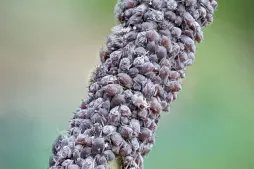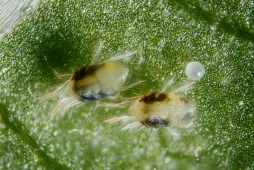Asparagus densiflorus, a fern-like asparagus
Asparagus densiflorus first appeared as an ornamental plant in Europe at the end of the 19th century. This South African variety belongs to the Asparagaceae family. But with its delicate, airy foliage, it looks more like a fern than an asparagus.
How to recognize Asparagus densiflorus, the ornamental asparagus?
Asparagus densiflorus is a bushy herbaceous plant. Ornamental asparagus grows rapidly. After three or four years, it measures 80 cm in height and 60 cm in spread.
The plant grows from tuberous roots. These give rise to flexible, drooping stems. Depending on the botanical species, these are more or less branched. But in some cultivars, such as asparagus densiflorus 'Myers, they do not divide.
The green, highly dissected foliage resembles that of ferns. Except that instead of fronds, Asparagus densiflorus has cladodes. These short, thin sections resemble limbs or spines. In reality, they are branches or twigs that do not sting. If you look closely, you can see tiny leaves at their base.
Unlike ferns, Asparagus densiflorus flowers. Although this phenomenon is rare indoors, in its natural environment, ornamental asparagus is adorned with tiny white flowers.
These turn into red berries, filled with seeds.
The plant and its fruits are toxic to humans and pets. They can cause digestive disorders and skin allergies.
Our maintenance tips
Your Dense-flowered asparagus needs light. But its delicate foliage cannot withstand the strongest sunlight. Indoors, place the plant behind a window screened by a curtain. Outdoors, prefer half-shade.
Watering
Asparagus densiflorus like to keep their substrate moist, but hate to have a soggy root ball. Water when the soil begins to dry on the surface.
Use non-calcareous water, such as rainwater, at room temperature.
Asparagus densiflorus plants need copious watering. Pour in water until the excess runs off through the drainage holes.
Leave your Dense-flowered asparagus to drain for a few minutes, then put the plant back in its place. Also remove any water stagnating in the saucer or planter. It could rot the roots.
Spray
If the air in your home is dry, spray the leaves of your plant with non-calcareous water at room temperature.
Repotting
In spring, transfer your Asparagus densiflorus to a larger pot, so that it can continue to grow.
Choose a pot with holes larger than the root ball. Use a plastic pot rather than a terracotta one. This material retains more moisture. Moreover, the plant develops vigorous roots. It is not uncommon for them to break clay containers. Plastic is more resistant.
Pour a layer of potting soil for green plants at the bottom of the pot. Plant your subject in the center and fill in with substrate.
Press down and water generously to remove air bubbles.
Your Dense-flowered asparagus doesn't like too dry an atmosphere. Place the pot on a dish filled with moist clay balls to improve humidity.
Fertilization
You can stimulate the development of your plant during its growth phase, in spring and summer, with fertilizer.
Apply green plant fertilizer once a month. Asparagus densiflorus is not a very greedy variety. Halve the dose recommended by the manufacturer.
Prune
Cut back older stems to one or two centimetres from the ground to encourage new branches.
Prune branches to balance shape and maintain a compact habit.
Plantation
Once the last spring frosts have passed, you can plant.
Choose a well-exposed location, away from direct sunlight.
Dig a hole about 25 centimetres deep. Place a layer of compost at the bottom to enrich the soil. Work the soil to loosen it. If necessary, add sand.
Plant your Dense-flowered asparagus without burying the crown. Fill in and water to encourage rooting.
If you're building a bed, keep a 50-centimeter spacing between the various specimens.
Cutting
Cutting is carried out during the strong growth phase, generally in spring and early summer.
When repotting, divide the plant in two or three. Remove the soil from the roots to better locate the rhizomes. Using a clean knife or serpette, cut the roots. Be careful not to cut the tubers.
Obtain a perforated pot. Fill the bottom with potting soil for green plants.
Plant your cutting and fill with substrate. Tamp and water to remove air bubbles.
Diseases / Threats
Information
| Family | Asparagaceae - Asparagaceae |
| Type | Asparagus - Asparagus |
| Species | Dense-flowered asparagus - Asparagus densiflorus |
| Lifecycle | Perennial |
| Foliage | Evergreen |
| Exposures | |
| Substrat | |
| Planting methods |
Open ground In pots In tubs Planter |
| Categories | |
| Tags |
Beginner Fritillary Toxic |
| Origin |
South Africa |
| Hardiness (USDA) | 9b |
| Leaf color |
|
| Flower color |
|
| Fruit color |
|
Discover plants from the same family
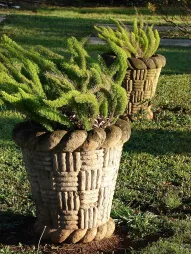
Asparagus densiflorus 'Myers
Discover
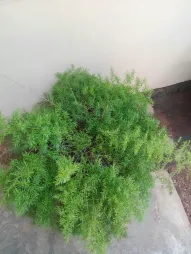
Asparagus sprengeri
Discover
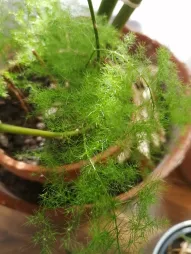
Florist's asparagus
Discover
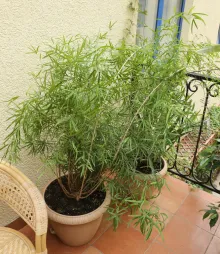
Asparagus falcatus
Discover













